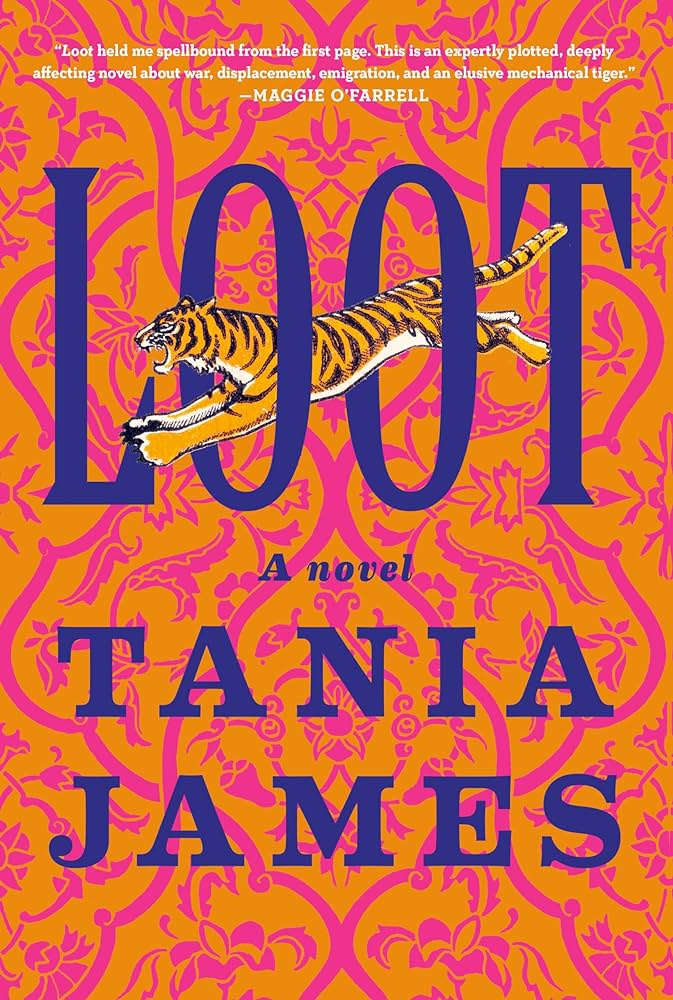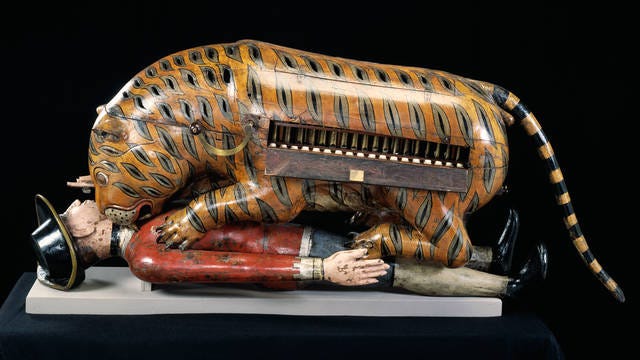#45: A Close Reading of the Surprising Omniscient POV in LOOT by Tania James
Tania James, plus a reading list of excellent contemporary fiction
In my contemporary fiction class this semester, my MFA students and I have read one novel or story collection each week, with all of our books having been published in the past ten years. Each book I chose for the class is notable or interesting in its own way: There are NYT bestsellers, award winners, critical darlings, and other categories represented, as well as books from presses of various sizes; there are books from a variety of genres, including literary fiction, commercial fiction, horror, sci-fi, crime, and fabulism, plus one book in translation. There are books emplaced in the borderland where my university resides, and ones that take place throughout the United States or across the globe. We read one novel by an alumnus of our program, so that we had a contemporary who's shared our direct literary lineage, as well as a choice of three books from unaffiliated local writers working in or visiting our city, who are of course also our contemporaries. (If you’re curious about the reading list, it’s at the bottom of this email.)
Generally, I’ve already read the books I teach at least once before putting them on the syllabus, and then I reread alongside my class. (It’s hard for me to be sufficiently passionate about teaching a book if I haven’t read it recently.) But I always put a couple books on the syllabus that I want to read but haven’t gotten to, so that at least some of my experience is as fresh for me as it is for my students.
This semester, one of those books was Loot by Tania James, which was longlisted for the National Book Award. (Years ago, I taught her The Tusk That Did the Damage in another class, and I highly recommend it as well.) If you haven’t read the novel yet, here’s the jacket copy:
Abbas is just seventeen years old when his gifts as a woodcarver come to the attention of Tipu Sultan, and he is drawn into service at the palace to build a giant tiger automaton for Tipu’s sons, a gift to commemorate their return from British captivity. His fate—and the fate of the wooden tiger he helps to create—will mirror the vicissitudes of nations and dynasties ravaged by war across India and Europe.
Working alongside the legendary French clockmaker Lucien Du Leze, Abbas hones his craft, learns French, and meets Jehanne, the daughter of a French expatriate. But when British forces attack and loot Mysore, Abbas’s world is turned upside down and his tiger automaton is seized as a prize of war. To prove himself, Abbas must retrieve the tiger from an estate in the English countryside, where it is displayed in a collection of plundered art.
Here’s your spoiler alert: I don’t think anything below will ruin the reading of Loot, but if you want to experience the novel entirely on your own first, don’t go past the photo. Come back after you’ve read it!
Still with me? Then here we go.
Throughout Loot, James imaginatively inhabits the gap in the historical record surrounding the origins of Tipu’s Tiger, a musical automaton seemingly created by a collaboration between Indian and French artisans and inventors and seized by English colonizers when Tipu Sultan’s palace was captured at the end of Fourth Anglo-Mysore War.
This battle happens 115 pages into Loot, as the turning point out of the novel’s first act, which depicted the making of the automaton by the woodcarver Abbas and the clockmaker Lucien de Luze. The chapter that depicts Tipu Sultan’s last battle—“The Siege”—is a master class in the possibilities of the omniscient point-of-view, which James employs throughout her novel to great effect. Up to this point, the woodcarver Abbas has been the novel’s primary point-of-view character (although there have been plenty of dips into other POVs too), but this chapter begins with more narrative distance than anything the novel has offered so far. It opens in what could arguably be Tipu Sultan’s POV but seems almost to be from the point of view of his fort, or of history itself:
The fort has known violence in its lifetime. Tipu Sultan took it from the Nawab of Arcot, who took it from the Peshwas, who took it from the Wodeyars, who took it from Timmana Nayaka, who took it from the earth somewhere in the fourteenth century. Even its birth, like all births, was a violence.
But no one has sent a cannonball at the walls before. No enemy has known—as the English know—that the northwest wall of the fort is the weakest. This is the sort of knowledge that could only be granted from someone on the inside. And there are many on the inside who might have granted it.
So the cannon fires; so the northwest wall breaks like biscuit.
Mines are laid beneath the breach. They explode, even as the Mysoreans are rushing to plug the hole with broken stone, their own bodies broken to rubble.
For the first time in its life, the fort is unstable, uneven. Mysorean troops guard the breach overnight. If these fort walls could talk, they would say that the head of these troops—Mir Sadiq—is in the pocket of General Harris.
“The Siege” is composed of short sections separated by white space; the paragraphs inside each section are generally quite short. All of this contributes to a dizzying reading experience, as James moves quickly from place to place and perspective to perspective. After the opening section (quoted in its entirety above), the next section follows a nameless mass of English forces “flowing through the breach…” and “[wading] through the Kaveri River” into the fort in just four short paragraphs; the paragraph that follows shows the armies of the East India Company entering the battle:
The armies of the East India Company—the Light Dragoons and Regiments of Foot, the Swiss mercenaries and Scotch brigades, the sepoy forces of Madras and Bengal—pour into the streets. They shoot every Mysorean in sight, primed on stories of Tipu’s dungeons, tales of nails being driven into innocent eyes (no proof of this, but proof, at present, is beside the point). It’s all so bloody easy. The give of stone walls, of sternum against steel. Thousands of dying Mysoreans. Any one of them could be Tipu Sultan. They don’t know what he looks like, having only heard reports of a wild-eyed fat man with a black mouth and a bloodthirsty laugh.
It’s all so bloody easy. The adjective there seems to be a Britishism attaching to the East India Company soldiers, even though we’re in no one person’s POV—what is it? Maybe a thought rising from the mind of one of these soldiers, or of all of them. The section continues:
There is Tipu’s personal palace with its tall, ribbed columns, untold treasures for the taking.
Also for the taking: the women and girls of the zenana.
Four will be immortalized in a popular English engraving, lips thin and smirking, torsos twisted in protest against the soldiers who are carrying them off. In the engraving, the men appear lusty and leering. In reality, they are efficient in their taking, tactical and cold.
Of the women, some scream and some don’t. Some proffer jewels in exchange for immunity. One, for whom it’s too late to proffer anything, staggers around a corner, clutching the torn drawstring of her skirt. Know that she will survive this night and many to come. What will sustain her is the story that will form in her mind, in which she is not the spoils of war but a fallen warrior.
In the third paragraph above, James zooms entirely outside the present moment, narrating instead from the POV almost of an art historian, writing from the present moment; in the paragraph’s last sentence, her narrator returns to the time narrated to comment on the “in reality” thoughts of the soldier-rapists.
The final paragraph of this section turns—for the first time this chapter—from the English to the Indian occupants of the fort, specifically “the women and girls of the zenana,” and then gets even closer to a single woman, the one “clutching the torn drawstring of her skirt,” for whom James imagines a future story, a future self-myth beyond the brutality of this moment.
James moves on, resuming her breakneck pace through the siege. In the next section, “the victors discover near the Water Gate the dead body of Tipu Sultan,” which they lay out on a palanquin (where an English soldier comes along to snip off part of Tipu’s mustache, something so shocking to me that I knew it had really happened); the one after it again describes one of the paintings that will be made of this moment, using it to transition to our protagonist, Abbas, and acknowledging for the first time his presence during the battle:
Of the nine paintings imagining the final moments of Tipu Sultan, exactly zero contain Abbas, cowering behind a broken pillar, hand in hand with the Wonder Hand.
An odd pair, these two. And yet each man is all the other has, an alliance born of sheer happenstance. Ten minutes earlier, Abbas had been staggering down an alley, trying to find his way out of the fort, when a distant cannon blast shuddered through the soles of his feet…
Again, the omniscient POV and James’s faculty with shifting narrative distance allows for interesting effects: in the first paragraph above, she takes the artistic depictions of Tipu Sultan’s death and inserts her invented Abbas into the moment, then follows him toward Tipu Sultan’s death, inhabiting that moment with Abbas remembering the last time he will ever see his family and his own dying father, days before the battle: “In preparation for leaving, Abbas helped his family load their bullock cart with possessions. Farooq had already fled with his wife and children to her brother’s house in Somnathpur. Junaid had received a delay on the start of his service so he could deliver the rest of the family to Shimoga, from where he would not be returning. Abbas refused to go along with either of these plans, no matter how his mother cursed and cried and how his brothers threatened to knock him unconscious and carry him off…”
The next section returns the reader to Abbas during the battle, now in close third POV to our protagonist for the first extended scene of “The Siege”: not coincidentally, I think, this is the longest section of the chapter. Abbas risks himself to aid a man called the Wonder Hand, then is injured himself and is rendered unconscious, possibly dying.
With Abbas removed from play, James zooms back out again, returning to what I think of as the “fort POV” from the opening of the chapter:
Here comes the first rain of the season—the very rain Tipu had been praying for, the rain that might have saved him—hurtling in torrents, tearing up the dirt, dousing the piles of stinking bodies. The sky throbs with lightning; thunder rolls through the earth. Relentless, the storm folds the rot into itself. Not erasing it entirely; that will take time.
The fort has time. The rain washes the cracks between its stones, the breakage in the wall. The water mixes with blood, and carries it down gutters and drains. The Water Gate swells, the river rises. Smoke moves over Srirangapatna, seething from flattened homes, christening the city, which will thenceforward go by a name that its conquerors can (sort of) pronounce: Seringapatam.
As narrative distance collapses toward the human again, we return not to the Indian inhabitants of the fort, but the perspective of the looting soldiers, including General Harris, the commander of the assault who orders Tipu’s real, living tiger Bahadur Khan releases and then shot. The next section depicts the "Prize Committee” in which the English officers are awarded their choice of spoils from the fort’s plunder. It’s here that the automaton now known as Tipu’s Tiger is discovered and chosen by a soldier named Colonel Selwyn as a gift to his wife, the Lady Selwyn, who we won’t meet until the novel’s final act. This scene (which spans two sections) begins not from the English POV, but from that of the colonel’s aide-de-camp, “Rangappa Rao… a sepoy with the Madras Infantry,” a character hereafter known as Rum; it then switches (after a break) to Colonel Selwyn, who choses the Tiger for his wife to mollify her want for “an object of genuine flair and drama.”
With Tipu’s Tiger now set on its actual historical trajectory to England, James’s narrator again steps out of direct scene to discuss Tipu Sultan’s library, a repository of local and international culture, science, and other learning, four thousand volumes strong, of which only 800 will be saved and plundered and sent to London or Calcutta; all the rest will be presumably lost ten years later, James writes, when Tipu’s personal palace is ordered razed by the English.
With the history of the siege and its aftermath settled, James has only one task left to complete: to put our protagonist Abbas back on the path of the automaton he helped bring into being. The final section of “The Siege” takes place three days after the fighting has started, and is from the POV of the “youngest sepoy, a boy of sixteen,” tasked with clearing the bodies of the dead and dragging them to the river. It’s he who sees Abbas escape the scene, although he does not know who he sees, and cannot imagine the import of what he witnesses to us, the reader who knows more than this character. The sepoy sees what he thinks is a jinn, “staggering up from the field of bodies… a jinn in the form of a slight young man”:
To his astonishment, the jinn turns and limps toward the Delhi Gate. The sepoy watches, relieved at first, then unsure; his friend never said anything about limping jinns.
Could be the jinn is no jinn, he thinks. Could be what he thinks to be a jinn is, in fact, a man. A man who has been lying for three nights beneath a corpse, a man silent yet alive, sweltering in his thirst, sucking rainwater from puddles when no one was looking, wetting himself, blacking out, waking and waiting for the moment to rise.
But who would believe a thing like that?
The sepoy watches until the figure disappears through the Delhi Gate, glad to see it gone, though certain it will surface in some other place, some other form.
I love this chapter so much, for its daring narrative bravado, for breaking so many “rules” at once, for reminding me (as all of Loot does) of the multitude of surprising pleasures one novel can deliver. It’s a spectacular set piece in the middle of an enthralling book, and I know I’ve only just begun to study how James pulled it off.
I don’t have any insight into James’s composing of this chapter—although I would love to ask her about it!—but I did find this interview answer of hers where she discusses the slippery POV that characterizes so much of Loot:
The most mysterious surprises, for me, often happened on the sentence level, when the perspective would pivot toward what seemed to be a marginal character, and entered their mind, and showed us that these seemingly insignificant characters have lives and psychologies as rich as the so-called ‘main character.’
I love the implication that all of the above happened for James first at the level of the sentence, with the prose guiding her from person to person, voice to voice, angle to angle. It’s a reminder to me to trust that my instincts at the level of syntax and grammar might lead to larger scale insights, larger scale delights. I can already feel that studying this chapter might for a time make me a braver writer, more willing to take unexpected risks at the level of the sentence and the scene. Here’s hoping it might one day do the same for you.
My Contemporary Fiction Syllabus for this Spring 2024 Semester:
Thanks so much for reading! If you’re not already subscribed, please consider doing so by clicking the button below. This post is also publicly accessible, so feel free to share!
Matt Bell’s novel Appleseed (a New York Times Notable book) was published by HarperCollins in July 2021. His craft book Refuse to Be Done, a guide to novel writing, rewriting, & revision, is out now from Soho Press. He’s also the author of the novels Scrapper and In the House Upon the Dirt Between the Lake and the Woods, as well as the short story collection A Tree or a Person or a Wall, a non-fiction book about the classic video game Baldur’s Gate II, and several other titles. His writing has appeared in The New York Times, Esquire, Tin House, Conjunctions, Fairy Tale Review, American Short Fiction, and many other publications. A native of Michigan, he teaches creative writing at Arizona State University.







Matt, nice analysis of POV. Tomorrow X3 has POV shifts in scenes for similar broadening of perspective. Are you teaching another contemporary fiction class in the near future? If so, I’d like to audit remotely.
BTW, ASU has a fine deep space faculty and program, an excellent resource for SciFi writers.
It is generous of you to share the reading list (and time consuming to link the books!) THANK YOU! I love to hear about how others teach classes and the materials they use. You inspired me for a Bradbury Trio course I teach to add an award winner week. I always gain something from your newsletter even if I don't comment all the time. Great work!